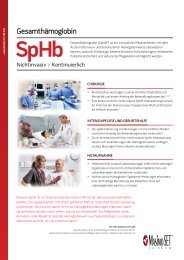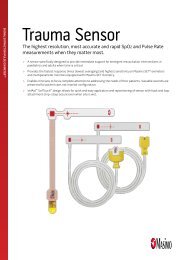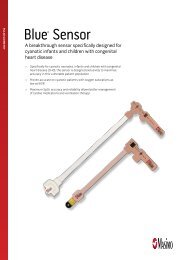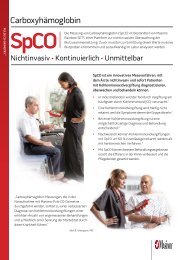Carboxyhemoglobin - Masimo
Carboxyhemoglobin - Masimo
Carboxyhemoglobin - Masimo
You also want an ePaper? Increase the reach of your titles
YUMPU automatically turns print PDFs into web optimized ePapers that Google loves.
2. Pulmonary Disease<br />
Exhaled CO is increased in patients with inflammatory pulmonary diseases such as bronchial asthma,<br />
bronchiectasis, upper respiratory tract infections, and seasonal allergic rhinitis. 49-53 Treatment with inhaled and<br />
oral corticosteroids, which have been shown to reduce airway inflammation, is associated with a reduction in the<br />
exhaled levels of CO in asthma. 54 Furthermore, exhaled CO is increased in exacerbations of bronchial asthma<br />
induced by respiratory virus infections. 55 Based on these findings, it has been proposed that measurements of<br />
exhaled CO may serve as an indirect marker of airway inflammation. 56-61<br />
Exhaled CO concentration is reported to correlate closely with blood COHb in smokers and non-smokers, 62 which<br />
suggests that the COHb levels may increase in patients with inflammatory pulmonary diseases. A study that was<br />
undertaken to determine whether arterial blood COHb increases in patients with inflammatory pulmonary diseases<br />
confirmed that COHb concentrations are increased in patients with bronchial asthma, pneumonia, and idiopathic<br />
pulmonary fibrosis (IPF). 63 Increased blood levels of COHb in patients with inflammatory pulmonary diseases may<br />
reflect lung inflammation. This finding was seen as a benefit for ventilatory limited patients, especially children, who<br />
cannot perform the vital capacity maneuver to measure exhaled CO. Also, patients with lung disease demonstrate<br />
poor correlations between COHb in the blood and exhaled values. The continuous measurement of blood levels of<br />
carboxyhemoglobin allows a trending presentation that graphically depicts subtle yet clinically significant elevations<br />
in COHb, providing a simple and valuable marker to indicate pulmonary inflammation.<br />
Cystic fibrosis treatment stands to benefit in particular. Inflammation, oxidative stress, and recurrent pulmonary<br />
infections are major aggravating factors in cystic fibrosis. NO, a common marker of inflammation, is not increased<br />
in cystic fibrosis patients probably because it is metabolized to peroxynitrite, 64-65 making this measurement of little<br />
use for monitoring lung inflammation in cystic fibrosis. However, exhaled CO which is induced by inflammatory<br />
cytokines and oxidants, has been established as an effective noninvasive marker of airway inflammation and<br />
oxidative stress. 66 If CO measurement were simple and non-invasive it could be used to continuously monitor all<br />
patients with severe disease.<br />
V. Detection Systems: Expired CO, CO-Oximetry and Pulse CO-Oximetry<br />
whitepaper<br />
Two methods have been widely studied for assessing CO concentrations in clinical practice: exhaled CO and<br />
COHb levels measured via CO-Oximetry. The differences between the readings obtained from the two methods<br />
have deemed exhaled CO to be clinically acceptable for the purposes of epidemiological studies, but only in<br />
those few patients who can perform a robust, repeatable vital capacity maneuver and in those patients without<br />
cardiopulmonary compromise.<br />
While the end-expired method can be used to measure moderate and low COHb levels in individuals, patients<br />
admitted with CO poisoning or who are otherwise critically ill are not in a state to blow a sample of expired air into<br />
an analyzer sample reservoir. Therefore, taking a sample of blood is the primary method by which COHb level is<br />
measured in cases with high acuity.<br />
In hospitals, the most common means of measuring CO exposure is a CO-Oximeter. A blood sample, under a<br />
physician order, is drawn from either venous or arterial vessel and injected into a laboratory CO-Oximeter. The<br />
laboratory device measures the invasive blood sample using a method called spectrophotometric blood gas<br />
analysis. 67 Because the CO-Oximeter can only yield a single, discrete reading for each aliquot of blood sampled,<br />
the reported value is a noncontinuous snapshot of the patient’s condition at the particular moment that the sample<br />
was collected. Another issue that profoundly affects the clinical usefulness of invasive CO-Oximetry relates to the<br />
relative paucity of devices currently purchased by and installed in acute care hospitals. One recent study indicates<br />
that fewer than half of hospitals in the U.S. have the necessary equipment on site to diagnose CO poisoning. 68<br />
For those that did not have the testing equipment, the average time to receive results of a blood sample sent to<br />
another facility was over 15 hours.<br />
7






